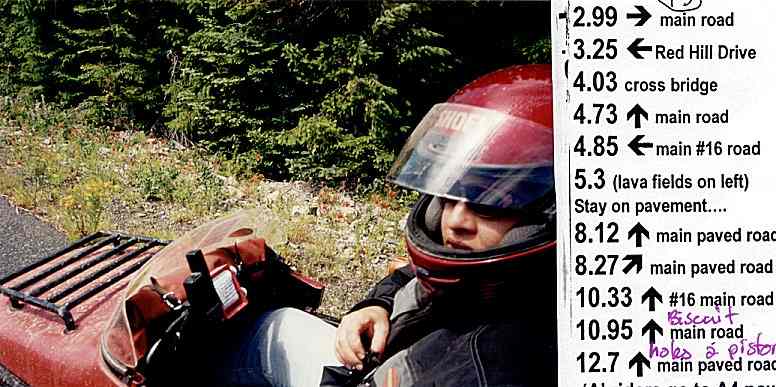
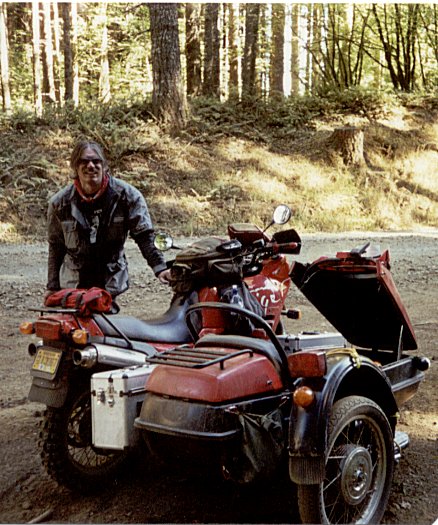 A Three Legged Dog
A Three Legged DogAn introduction to off-road sidecars
By Vernon Wade
I caught the Dualsport Rally bug in 2001. I did the Rat Dog that year and did the Black Dog in 2002. If you were at those events, you probably saw me. I was on the red Triumph Tiger with the sidecar. Maybe you were a little curious about my ride.
Sidecars are an oddity amongst the general motorcycling population and they are a down right rarity at dualsport events. Thatís too bad because dual sporting is a niche sidecars fill particularly well. True, their width precludes them tearing up the snaky single tracks we have in abundance in our Northwest forests, but almost everything else is fair game. That third wheel allows you to attack mud and gravel with an impunity usually reserved for the most skilled or the clinically insane solo rider. You can stay on the throttle without fear of tipping over, enjoying heart stopping slides on surfaces that cause most riders to pucker.
A sidecarís asymmetrical quality requires some skills unique to this vehicle. Neither fish nor fowl, it looks like it should behave like a motorcycle, but handles more like a go cart one wheel fell off of. Try to counter steer like a bike and you are apt to plow straight ahead. You need to drive it like a car, steering the direction you want to go. Unlike a car (or just about anything else), right and left turns require different techniques.
In the
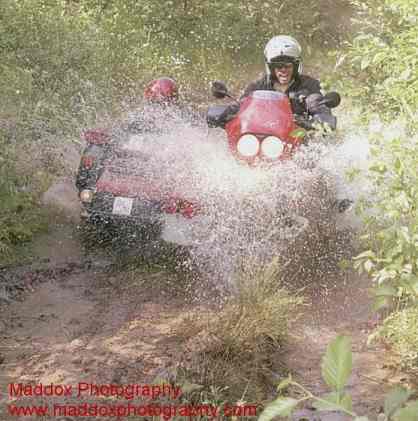 Grabbing
the front brake will make the sidecar want to pass the bike, causing you to
veer left. Entering left turns, you brake late, and drag the front brake just
shy of lock up to get the bike to pivot left. On loose surfaces you can tap the
rear brake to get the back tire to slide and then apply throttle as it kicks
out. Too much throttle too soon will cause the front wheel to lift and you lose
steerage, pushing the tire straight ahead even if you are at full lock. Left
turns are deceptive because you slide so easily and it seems so controlled. The
weight transfers toward the sidecar nose as you turn; the rear tire unweights
and starts to slide. The problem comes when the weight shifts too far and the
bike tries to come over the sidecar. The rear wheel comes clear off the ground
and the sidecar noses into the ground. Tip-overs are unusual, but they can
happen very quickly. To prevent this, the passenger and the driver need to shift
their weight to the left and aft. It is better to use the front brakes and
throttle to slide the bike around the corner, rather than standing on the rear
brake. Because an active passenger, shifting her weight all over the sidecar, is
required for spirited riding, they are often referred to as ďmonkeysĒ.
Grabbing
the front brake will make the sidecar want to pass the bike, causing you to
veer left. Entering left turns, you brake late, and drag the front brake just
shy of lock up to get the bike to pivot left. On loose surfaces you can tap the
rear brake to get the back tire to slide and then apply throttle as it kicks
out. Too much throttle too soon will cause the front wheel to lift and you lose
steerage, pushing the tire straight ahead even if you are at full lock. Left
turns are deceptive because you slide so easily and it seems so controlled. The
weight transfers toward the sidecar nose as you turn; the rear tire unweights
and starts to slide. The problem comes when the weight shifts too far and the
bike tries to come over the sidecar. The rear wheel comes clear off the ground
and the sidecar noses into the ground. Tip-overs are unusual, but they can
happen very quickly. To prevent this, the passenger and the driver need to shift
their weight to the left and aft. It is better to use the front brakes and
throttle to slide the bike around the corner, rather than standing on the rear
brake. Because an active passenger, shifting her weight all over the sidecar, is
required for spirited riding, they are often referred to as ďmonkeysĒ.
In addition to lurid power slides, another advantage to sidecars becomes apparent when navigating. We set my rig up with the roll chart and GPS mounted on the grab bar in the hack. The passenger did all the navigating allowing me to concentrate on driving. Communicating via a radio headset and using the GPS for a trip meter we were able to negotiate the course at full speed, without needing to stop to check the roll chart. The GPS would occasionally lose accuracy in the forest, so I would back it up using the motorcycle odometer, setting both back to zero when the roll chart indicated a reset. I think a simple bicycle speedometer with an odometer/trip meter function would work well for this. The SIGMA BC401 is about $19 and looks like it would serve. If you use a GPS or a bike speedo be sure the trip meter function is easy to zero and your navigator is familiar with itís use BEFORE you get out on the course (right Biscuit?;-).
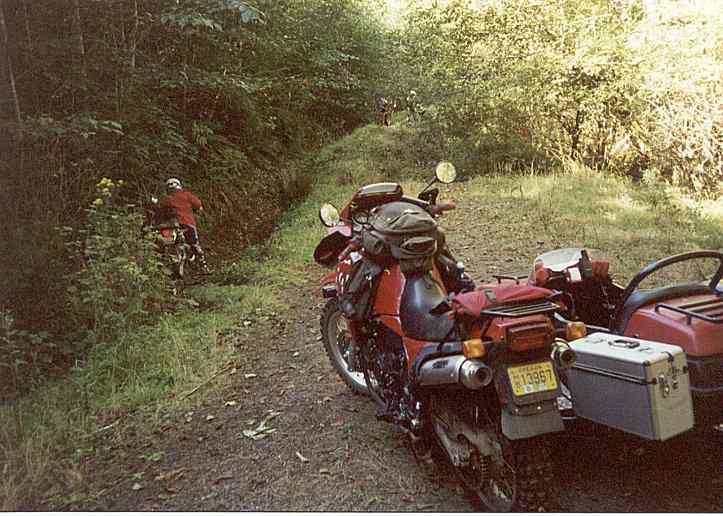 There are
also a few situations where a sidecar is at a disadvantage. Already mentioned,
the width will keep the rig off the single tracks. When approaching water
crossings, it is prudent to bear in mind all the slurry thrown up by the front
wheel will land in the sidecar, inundating your monkey.
A dualsport rig with adequate ground clearance will be a little slower on
twisty paved sections, due primarily to its high center of gravity. Extremely
steep sections can be difficult to negotiate. If you lose traction on a steep,
loose incline the rig will try to slide sideways off the track.
Fallen trees canít be easily hopped; you need to build a ramp for both
the sidecar wheel and the bike on both sides of the tree, cut it out of the way,
or go around it. Badly rutted roads can be hard-if all three wheels drop in you
can high center and become trapped. If one wheel drops in and out it can really
twist and hammer the frame. On rough roads I weave through the obstacles, taking
up the entire road trying to miss the biggest rocks and holes (if you come up
behind me, beep your horn and I will pull to one side to let you by). Sidecars
take a lot of physical effort to drive quickly over rough terrain. After a long
day on the course your arms and wrists get very tired.
There are
also a few situations where a sidecar is at a disadvantage. Already mentioned,
the width will keep the rig off the single tracks. When approaching water
crossings, it is prudent to bear in mind all the slurry thrown up by the front
wheel will land in the sidecar, inundating your monkey.
A dualsport rig with adequate ground clearance will be a little slower on
twisty paved sections, due primarily to its high center of gravity. Extremely
steep sections can be difficult to negotiate. If you lose traction on a steep,
loose incline the rig will try to slide sideways off the track.
Fallen trees canít be easily hopped; you need to build a ramp for both
the sidecar wheel and the bike on both sides of the tree, cut it out of the way,
or go around it. Badly rutted roads can be hard-if all three wheels drop in you
can high center and become trapped. If one wheel drops in and out it can really
twist and hammer the frame. On rough roads I weave through the obstacles, taking
up the entire road trying to miss the biggest rocks and holes (if you come up
behind me, beep your horn and I will pull to one side to let you by). Sidecars
take a lot of physical effort to drive quickly over rough terrain. After a long
day on the course your arms and wrists get very tired.
Even given the above mentioned deficiencies, I find riding a sidecar through the woods one of lifeís great pleasures. It is a nearly invincible vehicle in the rough and you get to share the fun with a passenger. If you are tempted to get a sidecar I wholeheartedly encourage you to do so. If you have a sidecar and think you would like to enter a dualsport event, donít hesitate, just do it! You need to have some ground clearance, an odometer which reads in tenths of miles and a roll chart holder. Contact the eventís organizer ahead of time to be sure your rig will be able to negotiate the course. I hope to see you at the Dog!
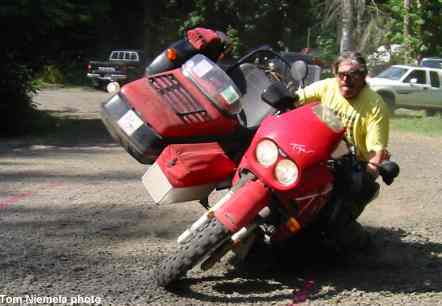 More
Information about Sidecars and Dualsport sidecars can be found at:
More
Information about Sidecars and Dualsport sidecars can be found at:
http://home.sprynet.com/~sidecars/dualsport/
http://www.dauntlessmotors.com/sidecars.htm
http://autos.groups.yahoo.com/group/SCT/
http://www.narma.org/narma/index.html
More information about dualsport events can be found here:
http://www.blackdogdualsport.com/
http://autos.groups.yahoo.com/group/Oregon_DSR/
Examples of roll charts and bicycle speedometers can be found here:
http://www.bicyclezone.com/computers.htm
http://home.riverview.net/aroneous/rolch.html
http://www.dual-star.com/index2/Equipment/roll_chart_holder.htm
http://www.fso.cc/RouteChartsPlus.html
